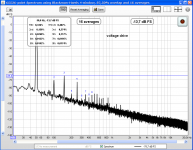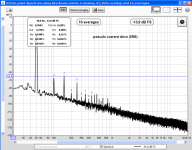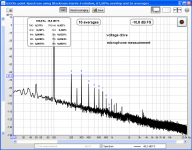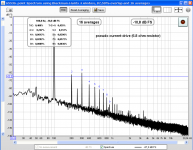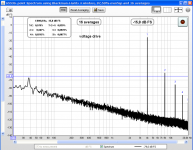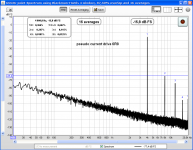It is a good question, it is not. I can measure frequency response change and we shall see.
I forgot to show voltage distortion at amplifier output, attached now. It is 0.005% compared to 0.1% of current distortion.
Hi PMA
I would point out that you may have seen a reduction BUT…..
For one, neither 1V or 100Hz represent a level which produces problematic distortion. For a woofer, it is motion related nonlinearity that causes the largest problems and is generally reduced by a Voltage source over a current source.
Part B is that when you measure a loudspeaker that has low distortion, to be accurate, one needs to vector subtract the drive signal from the mic signal because the harmonics the amplifier produces either add or subtract from those the speaker produces. When I have HAD TO measure low distortion on a loudspeaker, the trusty old HP 3562 is an easy way to do it.
The kind of distortion loudspeaker folks are more concerned with is not the 1/10 percent range your measuring but the 20-50% harmonic distortion that woofers often produce driven at a normal level.
I have measured THD’s greater than 50% in some commercial subwoofers when driven at a fraction of rated power.
Lastly, to be fair too, one should compare THD’s while both producing the same SPL, much is tied to radiator motion. Bottom line, low frequency distortion is usually so bad it is one of the unmentionables in a market where numbers are used to sell
I would suggest you try your test again, instead of about 1/10 Watt (1v), put in say 10V, instead of using a frequency above the range where he problem is, try it at 25Hz or 30Hz, where the cone motion is evident and sound would be distorted.
I would encourage anyone who’s interested to measure how much distortion your woofers produce producing a modest level at a low frequency as a reality check.
Speakers aren’t like amplifiers or electronics, they are by far the weak link and have flaws in dimensions electronics don’t have. The flaws are hard to measure but actually easy to hear via a generation loss recording caricature of what is not faithful to the signal. We did these using a tower (semi anechoic), an earthworks measurement mic, 24/96 recorder and selected musical track. Doing these recordings at work back in the beginning, it would be rare to find a loudspeaker that was listenable after just 3 passes in a generation loss recording, many sound bad on one pass. Speakers that are still “ok” after a generation or two will generally sound good if captured by a microphone in a camcorder or eyefone recorder.
While not a usable number or accepted measurement of accuracy, I believe the audio version of the modulation transfer function at least can show if A is better than B. Here is the more common use of MTF’s in optics;
http://www.edmundoptics.com/technical-resources-center/optics/modulation-transfer-function
A group of MTF’s weighted to speech spectrum are used to calculate / predict voice intelligibility (STIpa) in a language independent way. In Europe, there is a great concern about this as many large permanent sound systems must also work as emergency warning systems.
Modern line arrays while the norm for live music, are not very intelligible (or musically accurate) and so in the last few years, a number of very large systems have been removed and replaced with a different approach. It turns out, a speaker that has a higher STIpa measurement when mounted and measured in the same position, will generally be more faithful to the musical signal, survive more generations.
Best,
Tom
One problem that I see here is that many of you live and work with cheap speakers
Really? Who? I can only think of one guy who insists that cheap computer speakers are the optimum thing for evaluation.
Hi Tom,
It was not a measurement with a microphone, but a comparison of distortion of speaker current with distortion of amplifier output voltage.
It was not a measurement with a microphone, but a comparison of distortion of speaker current with distortion of amplifier output voltage.
I'm not going to give Frank a hard time about his selection of speakers. He knows what he is working with, and I presume can listen through the inherent problems with a smallish speaker. Sometimes small speaker are actually more 'accurate' sonically than much bigger multi-way systems. I discussed this long ago with Richard Heyser, as we both had a K-horn as a reference, yet we found on human voice, for example that a smaller speaker actually gave a more accurate reproduction. IF you look ONLY at distortion, then perhaps a huge horn loaded system would be the best. Especially if we work hard to minimize horn throat distortion by using relatively large drivers. Would this be sonic nirvana? From experience, I would doubt it.
John,
one thing to remember here is that this is a diy forum and many people build there own speakers with the best commercially available speaker components. I think you need to think about the fact that cost of the final speaker has little to do with the cost of the components or the quality many times. Your Wilson speakers are a perfect example, they are extremely expensive but at the same time are made with nothing but commodity speaker components. Anyone with the skills could build those speakers for a fraction of the price Wilson charges, they are nothing special and in fact I have always found the Wilson speakers to be mediocre at best and they have had terrible high frequency response for years. So please give up on this costs is what matters, you are only fooling yourself on that point.
Could someone who has the equipment and the device show the difference in distortion profile between a normal long coil short gap speaker and a short coil long gap device? I will say that many of the issues spoken of here have to do with speakers where the coil is continuously leaving the gap, is very asymmetric in flux density and have poorly designed motor systems. I have gone in a very different direction and would love someone to test one of my designs for distortion and compare them to a similar sized speaker of standard design.
Richard Marsh,
You have a pair of my speakers that are broken in. If I send you some enclosures would you be willing to show the group what they can do? I think some might be very surprised and rethink some of what is being said in all this conversation. There is still much room for improvement even in my designs but I do think I have reduced many of the distortion generation factors with my motor design and cone material. I can say all I want but only real measurements will confirm some of what I am saying. I am not making exceptional claims such as high efficiency, they are not. or that I have changed the laws of physics. it is just a very careful look at some of the problems and some solutions I have worked out.
one thing to remember here is that this is a diy forum and many people build there own speakers with the best commercially available speaker components. I think you need to think about the fact that cost of the final speaker has little to do with the cost of the components or the quality many times. Your Wilson speakers are a perfect example, they are extremely expensive but at the same time are made with nothing but commodity speaker components. Anyone with the skills could build those speakers for a fraction of the price Wilson charges, they are nothing special and in fact I have always found the Wilson speakers to be mediocre at best and they have had terrible high frequency response for years. So please give up on this costs is what matters, you are only fooling yourself on that point.
Could someone who has the equipment and the device show the difference in distortion profile between a normal long coil short gap speaker and a short coil long gap device? I will say that many of the issues spoken of here have to do with speakers where the coil is continuously leaving the gap, is very asymmetric in flux density and have poorly designed motor systems. I have gone in a very different direction and would love someone to test one of my designs for distortion and compare them to a similar sized speaker of standard design.
Richard Marsh,
You have a pair of my speakers that are broken in. If I send you some enclosures would you be willing to show the group what they can do? I think some might be very surprised and rethink some of what is being said in all this conversation. There is still much room for improvement even in my designs but I do think I have reduced many of the distortion generation factors with my motor design and cone material. I can say all I want but only real measurements will confirm some of what I am saying. I am not making exceptional claims such as high efficiency, they are not. or that I have changed the laws of physics. it is just a very careful look at some of the problems and some solutions I have worked out.
I'm not going to give Frank a hard time about his selection of speakers. He knows what he is working with, and I presume can listen through the inherent problems with a smallish speaker.
OK, so when you sneered about cheap speakers, you were just making that up?
Steve,
unfortunately I am too far from your place and FedEx would cost a lot. Otherwise I would love to test your drivers.
Regards,
Pavel
unfortunately I am too far from your place and FedEx would cost a lot. Otherwise I would love to test your drivers.
Regards,
Pavel
Yes, I am sure.Are you sure it wasn't your amp having to swing twice the volts ?
Nice demo 🙂
Thank you Pavel. I have been very busy working with new people doing product designs and haven't spent much time on my speakers. I will see what I can do to get some of this out there. I could send the speakers by regular post and it just takes a bit longer to get there. I would need to assemble and break in a pair for proper testing.
Exactly, at acoustical side it looks quite opposite..The same speaker, voltage driven and through series resistor, to the same SPL
I will repeat your experiment tomorrow, just curious what I get with microphone.
I have had this, so far, with microphone, at 200Hz. About twice more distortion at 100Hz. Only voltage drive measured so far with microphone. Too much noise.
Attachments
Kindhornman, I'm glad to know that 'everybody' especially my critics, uses really good loudspeaker drivers in solid cabinets.
I recall having to listen to AR-2ax loudspeakers in a double blind test for TIM. I said that it all sounded distorted in either switch position, and I was a lousy test subject with those speakers.
As far as Wilson is concerned, I agree that they are 'overpriced' much like a Bentley is overpriced, with added 'value' that does not really add to the sound quality. However, I seriously doubt that you could copy or make something equivalent in his speaker cabinets. That is where he put his efforts. He doesn't design speaker drivers, so he has to live with what he can get, and I agree his tweeter needs improvement (from an absolute point of view). Perhaps we should talk here about loudspeaker cabinet resonances and Q, here as well. I know that Wilson uses exotic materials for his enclosures and they are expensive to produce compared to wooden enclosures.
I recall having to listen to AR-2ax loudspeakers in a double blind test for TIM. I said that it all sounded distorted in either switch position, and I was a lousy test subject with those speakers.
As far as Wilson is concerned, I agree that they are 'overpriced' much like a Bentley is overpriced, with added 'value' that does not really add to the sound quality. However, I seriously doubt that you could copy or make something equivalent in his speaker cabinets. That is where he put his efforts. He doesn't design speaker drivers, so he has to live with what he can get, and I agree his tweeter needs improvement (from an absolute point of view). Perhaps we should talk here about loudspeaker cabinet resonances and Q, here as well. I know that Wilson uses exotic materials for his enclosures and they are expensive to produce compared to wooden enclosures.
The flaws are hard to measure but actually easy to hear via a generation loss recording caricature of what is not faithful to the signal. We did these using a tower (semi anechoic), an earthworks measurement mic, 24/96 recorder and selected musical track. Doing these recordings at work back in the beginning, it would be rare to find a loudspeaker that was listenable after just 3 passes in a generation loss recording, many sound bad on one pass.
I love this idea. It reminds me of Alvin Lucier's piece, "I am sitting in a room", where he records his speaking voice and plays it back into the room, re-recording it over and over until all you hear are the room resonances articulated by his speech.
Exactly, at acoustical side it looks quite opposite..The same speaker, voltage driven and through series resistor, to the same SPL
Hi BV,
I have been too curious. I have made measurements at 3 frequencies, 50Hz, 100Hz and 4kHz. Voltage drive and drive with 6R8 series resistor. I am sorry I cannot confirm your result. At 50 and 100Hz, the distortion was almost same with voltage drive and resistor. At 4kHz, resistor drive was better.
Cheers,
Attachments
This is all you need to do to significantly reduce driver output distortion; Any high nfb (VFB) power amp can be modified easily for this configuration and tested with your own speaker of choice (I published this decades ago):
An Rs of .2-.5 works well.
View attachment Spkr FB.pdf
THx-RNMarsh
An Rs of .2-.5 works well.
View attachment Spkr FB.pdf
THx-RNMarsh
I'm not going to give Frank a hard time about his selection of speakers. He knows what he is working with, and I presume can listen through the inherent problems with a smallish speaker. Sometimes small speaker are actually more 'accurate' sonically than much bigger multi-way systems. I discussed this long ago with Richard Heyser, as we both had a K-horn as a reference, yet we found on human voice, for example that a smaller speaker actually gave a more accurate reproduction. IF you look ONLY at distortion, then perhaps a huge horn loaded system would be the best. Especially if we work hard to minimize horn throat distortion by using relatively large drivers. Would this be sonic nirvana? From experience, I would doubt it.
“I discussed this long ago with Richard Heyser, as we both had a K-horn as a reference, yet we found on human voice, for example that a smaller speaker actually gave a more accurate reproduction. IF you look ONLY at distortion, then perhaps a huge horn loaded system would be the best.”
Dick spent a great deal of time trying to tie what we can measure to what that thing sounds like, in his papers he called that a “map” between the two domains. While I have depended on his TDS system and many of his writings for inspiration over the years and still have a bunch of things I would ask him if only it were possible, there is an area which is largely overlooked which is differences in how speakers radiate.
In one of his last papers (friend and now co-worker was curator of the Heyser archives) Dick wrote about an ideal source having one location in time and space over a broad band, this is the only configuration which can be viewed anything like a signal on a wire.
As he wrote very early on, a loudspeakers acoustic phase represents a shift in the front to back position of the source, not physically but in time, his TDS system was the very first way to measure that.
That only measures one point in space and doesn’t represent what our ears and brain create for us with the inputs from two ears. Our ears can hear how a speaker radiates, a microphone can’t.
By that I mean, take pairs of speakers, set them up identically, eq them to the same response and play a soft voice in mono. You will notice that some or most speakers make a good phantom image in a specific spot in the center BUT you can also hear the right and left speakers as the source.
With a large array speaker (which radiates from many different points in space and time) the phantom image is more like “the middle” of a wall of sound and the right and left source very obvious. Extend that to a concert array and maybe you can detect a phantom image.
But if you take small / good full range drivers and put them flush in the middle of large baffles (and ignoring the lf and spl limits inherent in a tiny driver) and do this test, you will find the apparent loudness of the right and left source will be very low, maybe lowest of all and the phantom the strongest..
The reason is these radiate as a simple point source, reasonably smooth expanding bubbles if you will.
Another test of what i call "spatial identity" , play one speaker with a soft voice (our hearing is fine tuned to this sound) and close your eyes. With all loudspeakers it will be instantly obvious what direction the sound is coming from but if you compared the same speakers as above, you would find that the full range driver on the large flat baffle will be harder to “hear” how far away that speaker is while the ones that were the most obvious as the left and right source, were also the easiest to locate so far as their physical depth location.
Think about what property would allow one speaker to be easy to locate in depth with your eyes close while another would be hard (ideally impossible)?.
What you don’t want is an interference pattern, that can be from cabinet edges or multiple sources producing the same frequency.
John your spot on arrays of horns solve the output / distortion part of the problem, but by being physically larger and having mouth / directivity constraints, one makes a more severe interference pattern with them than smaller sources.
You can add drivers coherently BUT they must be less than ¼ wavelength apart at the highest frequency of interest (think close coupled subwoofers) and you can even do that within a single horn.
I know I am saying stuff that sounds odd or unlikely but it has been the path I have been following with some success. We are a small company that doesn’t advertise or pursue live sound outside EDM but in the last 4 years, our systems have replaced half of the “concert style” sounds systems in the 100,000+ seat stadiums and many smaller ones.
I think one can hear some of what I was talking about both in the generation loss thing and radiation here in a couple video’s for those who have headphones handy. When you radiate a simple “bubble” from one point in time and space, not an interference pattern like an array “it sounds the same” far away and even far away (some of these were taken 700-800 feet from the loudspeakers), the sound is floating in front of you. This canon vixia recorder’s mic’s and this is a lot bigger than a living room, a lot bigger than nearly all concerts but it is still possible to make good sound and loud and not sound like cutting a sheet of aluminum on a table saw. These systems are all mounted in the scoreboard, have a listen
https://www.dropbox.com/s/tnsw5mb4v5vdlwq/20120726122124.mts?dl=0
https://www.dropbox.com/s/oyosfc3adc6j1du/20130723135350.mts?dl=0
https://www.dropbox.com/s/1868goglj7k5n6f/20140805183020.mts?dl=0
I wish I could have Dick hear a couple of these systems live, he has had such an impact on my life starting with the TEF-10.
John you’re lucky to have known him, I met him tagging along with Don an Carolyn once and ended up at a dinner with a bunch of audio “hero’s” and I only said a few words all night. Like I said, Doug Jones and I have spent many hours discussion things he wrote and that I wish I could ask him about.
Best,
Tom Danley
This is all you need to do to significantly reduce driver output distortion; Any high nfb (VFB) power amp can be modified easily for this configuration and tested with your own speaker of choice (I published this decades ago):
An Rs of .2-.5 works well.
THx-RNMarsh
Begs the question, "where do I buy one ?", or maybe all this THD stuff doesn't amount to much.
So, two days later, no-one knows and/or cares whether the amp's damping factor has anything to do with this, and if it does to what extent?
Richard spoke of "high NFB" amp, which begs the question - what about low NFB amps, which use 26 dB or less of GNFB? How are they affected, more or less, and if as I suspect less, how much less, significantly or marginally?
Richard spoke of "high NFB" amp, which begs the question - what about low NFB amps, which use 26 dB or less of GNFB? How are they affected, more or less, and if as I suspect less, how much less, significantly or marginally?
Last edited:
I think it is obvious that some speakers benefit from current drive and some don't, for any given frequency. To state flatly that one is better is weirdly divisive. Perhaps, if you were designing an ideal speaker, choosing one or the other would allow you to make a better design in the end. But, we are comparing distortion examples from speakers that already exist so far.
The reason I asked about voice coil nonlinearity is because I've been playing with an electromechanical nonlinear speaker model in the simulator. I have the nonlinear suspension implemented, allowing the use of a tension vs displacement curve. I'm looking for other possible nonlinear mechanisms that can be modeled.
The reason I asked about voice coil nonlinearity is because I've been playing with an electromechanical nonlinear speaker model in the simulator. I have the nonlinear suspension implemented, allowing the use of a tension vs displacement curve. I'm looking for other possible nonlinear mechanisms that can be modeled.
- Status
- Not open for further replies.
- Home
- Member Areas
- The Lounge
- John Curl's Blowtorch preamplifier part II

